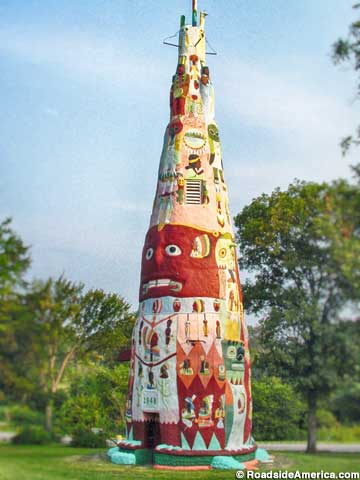
World's Largest Totem Pole: 90 feet tall, 134 tons.
Ed Galloway's Totem Pole Park
Foyil, Oklahoma
Nathan Edward Galloway (1880-1962) wanted to uplift the world with his wood art. Those dreams went up in smoke in July 1913 when his Springfield, Missouri, studio -- which unfortunately was part of a gas station -- burned down. Only one of his scorched wooden sculptures survived.
Without an income, Ed moved to Oklahoma and became a shop teacher for orphan boys. It wasn't until he retired in 1937 that his creative spark ignited again -- not in flammable timber this time, but in fireproof concrete.
In his front yard Ed built -- with rocks, steel, and cement -- what he called the World's Largest Totem Pole. It looks more like a 90-foot-tall totem rocket ship, or perhaps a teepee being stretched skyward by an Oklahoma twister. David Anderson, director of what is now called Ed Galloway's Totem Pole Park, said that Ed built the concrete pole as a tribute to Native Americans, although Ed wasn't one himself. "He said he wanted people to know that there was somebody here before us."
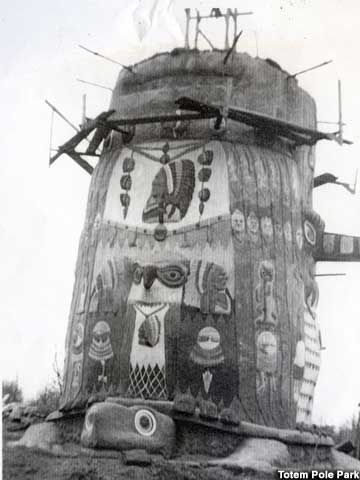
Totem Pole under construction, 1941.
The pole was built on a shoestring budget. Ed hauled the sand for his concrete, bucket by bucket, from a creek across the road. Sandstone rocks, which form the core of the pole, were dug by Ed out of the dirt. Reinforcing lumber and scrap steel were scavenged. "It's a massive structure, very strong," said David of the totem pole. A sign at its base gives its weight as 134 tons.
Ed painted the pole in bright colors, turning what would have been a towering blobby pile of gray into something memorable. He'd ask a neighbor to drive him into town -- Ed didn't have a car -- and he'd buy half-empty cans of used white paint, then mix in the colors himself.
Ed molded bas-relief flourishes, top-to-bottom, into the pole's wet concrete by hand: stylized lizards, birds, butterflies, fish, lobsters. He borrowed ideas from the indigenous art of the Pacific Northwest and Alaska, and from the Philippines, where Ed had fought in the Spanish-American War. He also gave the pole a lot of hand-molded Plains Indians in feathered headdresses. Most of this iconography has nothing to do with Native Americans living in Oklahoma -- David conceded that some of it is "very strange" -- but it satisfied Ed. According to early newspaper reports, his reference library consisted of picture postcards and several hundred photos from old National Geographics.
Ed completed the totem pole in 1948. Before he was even finished he'd also built an 11-sided concrete workshop -- now called the Fiddle House -- to display his woodwork. "He'd work all day on the totem pole, then work on the wood at night," said David. Ed had a brother who played the fiddle, which apparently inspired him to carve fiddles -- hundreds of them. None were playable musical instruments; they were just a way for Ed to showcase his skill. Some were inlaid with exotic hardwoods sent to Ed by his former orphan students who were fighting overseas.
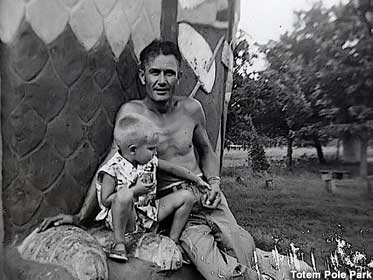
Ed Galloway and a young visitor in the 1940s.
When World War II ended, Ed's property -- which was on a main tourist route between Route 66 and Grand Lake -- became a popular stop for travelers. Ed built several smaller totem poles, and picnic tables and chairs, all made of similarly hand-molded and colorful concrete. He strung ropes of festive light bulbs between the poles. The big totem pole served as a kind of spectacular billboard -- similar to today's towering electronic signs next to freeway gas stations -- but Ed wasn't running a business. The park was free, and none of his woodwork was for sale. "He gave away his stuff," said David. "He had a metal can where people could drop money to help pay for the electricity."
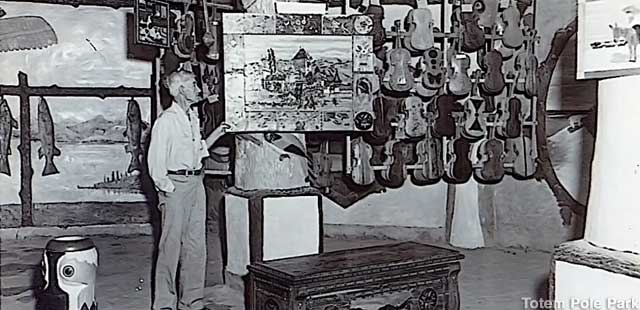
Ed with his wood art in his later years.
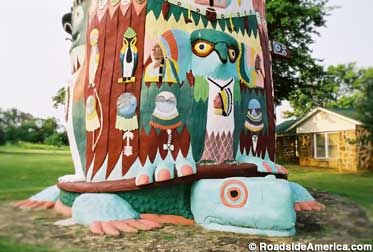
The Totem Pole is balanced on the back of a squashed tortoise.
Ed worked hard into his eighties and was planning new additions to the park when he died unexpectedly from cancer in 1962. His concrete creations gradually fell into disrepair. The grounds became overgrown. Most of Ed's fiddles were stolen and never returned.
By the late 1980s, however, Ed's fortunes had improved. He'd been recognized posthumously as one of America's noteworthy folk artists, and restoration work was begun on Totem Pole Park by the Rogers County Historical Society, the Kansas Grass Roots Art Association, and the Foyil Heritage Association. It's still underway. The Fiddle House was brought back from the brink of collapse, and Ed's original concrete colors have been duplicated with special mineral-based paints, which should stay bright into the second half of the 21st century.
It's taken longer to restore Ed's creations than it took Ed to build them, which says something about his persistence. David said that Ed's work ethic is an inspiration to "get out there and give it a try."
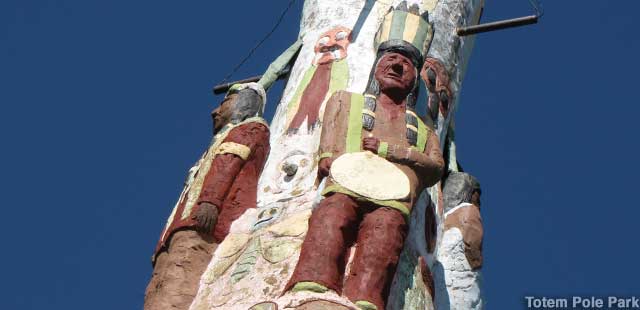
Nine-foot-tall Native chiefs keep watch over all four directions from the top of the Totem Pole.
Today, Totem Pole Park is a quiet, sloping expanse of lawn. Stands of trees shade Ed's concrete poles and picnic tables. The park is still free. Visitors can walk into a small room at the base of the big pole and look up through its hollow interior. The Fiddle House displays about 100 of Ed's surviving fiddles, and doubles as a gift shop and museum chronicling the history of Ed and his work. "All my life I did the best I knew," Ed is quoted as saying. "I built these things by the side of the road to be a friend to you."





